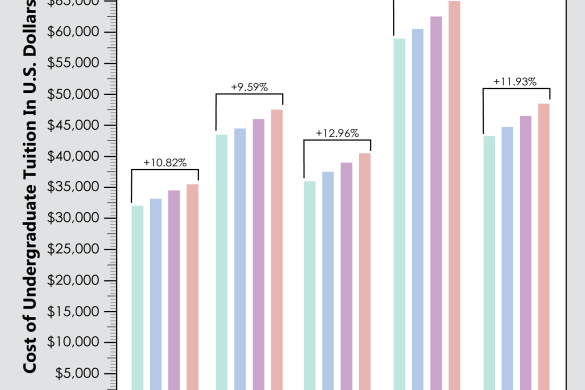With the end of first semester wrapping up, students are already searching for housing arrangements for next year, according to Associate Dean of Students Jonathan Yorkowitz. According to the University of Indianapolis’ website, the university has many opportunities for housing on-campus including campus residence halls and apartments, such as Greyhound Village and the University Lofts, opening next semester. According to Yorkowitz, there are several opportunities for students to find housing off-campus as well. He said that these include places such as rental houses in the University Heights neighborhoods, College Crossing Apartments and other options in the Indianapolis area.
UIndy has seven residence halls. Freshmen are allowed to live in Cory Bretz Hall, Crowe Hall, Cravens Hall and Warren Hall, and often make up most of the residents in those halls. In those dorms students can live with two to five people and share a communal bathroom. Junior accounting major and GV resident Andrew Dunkin lived in a dorm his freshman year and said that he feels that all students should live in the dorms for at least one year.
“For the dorms, I would say… it’s nice always having people around you, you’re never bored and you always have something to do,” he said.
This is one of the reasons senior social work and psychology double major Meaghan Owens has continued to live in the dorms. She lived in Cory Bretz her freshman year and then moved to Roberts where she stayed for three years.
“It’s very ‘homey,’” Owens said. “I see my RAs regularly and have built relationships with many of the people I live with. It’s fun too! We have a ton of events and ways to get to know people in our building.”
When living in a dorm, there is more support with multiple residence assistants around to offer supervision and mediation and plan activities for the hall. Sophomore studio art major Amanda Thompson, who lives in Central Hall, said that living in a dorm also offers more chances to meet people.
“I chose to live in the dorms for the first two years because I wanted to get out of my shell and meet new people that I might not have met otherwise…” Thompson said. “I think that living in the dorms, whichever ones you choose, they are experiences that make your time at UIndy and it’s a good way to meet new people if that is what you are looking for.”
Upperclassmen residence halls offer a variety of living situations. Central Hall features two double rooms joined by a shared common area, each with its own bathroom. Freshman also are allowed to live on the fourth floor of Central if they are part of the Strain Honors College in a triple room. East Hall is made up of single units with a bathroom shared by two rooms. Roberts Hall offers both single and double rooms with a bathroom shared between two rooms.
Thompson said she enjoys the convenience of living on campus and not having to worry about parking. However, she said one of the things she does not like about living on campus is that students must have a meal plan. When living in a residence hall students must purchase at least a 10-meal-a-week plan, but can also purchase a 14 or 19-a-week plan. For the 2018-2019 academic year, the 10-meal-a-week plan was $1,879 per semester, 14 was $2,431 and the 19 was $2,799, according to UIndy’s website.
Junior exercise science major Alyssa Stuczynski said she lived in the dorms for two years and then opted to move into GV at the beginning of this semester. GV offers one to four bedroom options, where residents will have their own room with a double bed and private bathroom. Each apartment has a shared kitchen, living room and laundry units. Stuczynski said that she decided to move out of the the dorms because she wanted to feel more like an adult.
“I’d say living in an apartment makes me feel like I have more responsibility and I guess that’s what I wanted,” Stuczynski said. “It makes me feel like I’m more of an adult instead of living in a dorm feeling like I’m still this freshman.”
When moving into GV, cost can be a factor; aside from the newest addition to campus housing, University Lofts, GV is the most expensive place to live, and rent is paid per semester. However, junior criminal justice major and GV resident Isabelle Christman said that despite the price, there are many positives to living in GV.
“[A] positive would be having your own kitchen, just because you have the freedom to make food whenever you want. You don’t have to worry about the dining hall closing, or if they have food that you don’t like there,” Christman said. “And then another positive would definitely be having my own room and having my own bathroom.”
Whether students live in university or off-campus apartments, they can opt to have a meal plan, including the five-meal-a-week plan which cost $807 a semester for 2018-2019. There are many off campus housing options near UIndy including renting houses in the University Heights neighborhood and various apartment complexes. Apartments within walking distance include College Crossing, University Place Apartments and National Place Apartments.
“For the dorms, I would say…it’s nice always having people around you…”
Dunkin said that he lived in College Crossing after his first year out of the dorms and said that it was similar to living in GV, however, he did have to make monthly payments. Dunkin said College Crossing is a really good option for living and students should explore their options because there are many. According to Yorkowitz, when moving off campus it is important to understand the legal responsibility that comes with signing a lease.
“Signing contracts is a serious legal responsibility versus signing a housing agreement in a residence hall is not as much responsibility,” Yorkowitz said. “So I would say that I would encourage students to do that, you know, to figure out what they want to do. Sign contracts, but be very careful with what you’re signing and what the requirements are with that because you’re going to be responsible legally for that.”
There are many factors that students should consider when deciding where to live. Yorkowitz said that it is important for students to think about their overall living expenses before making any decision about housing.
“When you live in a residence hall or our apartments, everything’s included so your internet’s included, your cable, like your streaming TV services are included, your utilities are included, the maintenance of the building is included, all those sorts of things,” Yorkowitz said. “When you’re a renter by yourself, you’re responsible for all those things yourself. And even [sometimes] the upkeep of the property while you’re living there, so sometimes there are unanticipated costs or even time costs to renting.”







